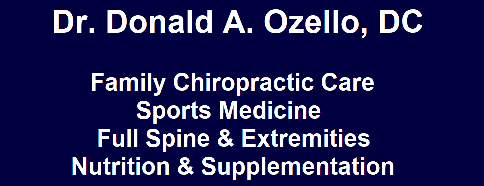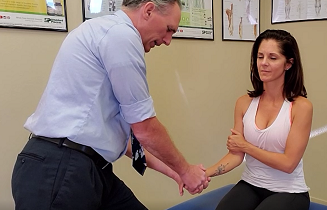Chiropractic treatment is effective for a wide range of conditions including carpal tunnel syndrome.
Chiropractic care is drug-free, surgery-free functional medicine. The primary objective of Chiropractic treatment is to restore proper skeletal motion and optimize nerve flow to maximize the body’s natural healing capabilities.
Doctors of Chiropractic utilize a treatment procedure named the chiropractic adjustment or manipulation. The chiropractic adjustment is a high velocity, low-amplitude, focused thrust that re-establishes proper motion to a joint and lessens impingement on a nerve. Chiropractic adjustments can be executed on any joint in the body including the spine, shoulder, elbow, and wrist.
Carpal Tunnel Syndrome (CTS) is the most common upper extremity nerve impingement syndrome. CTS is classified as a repetitive strain injury (RSI). The most common extrinsic source of upper extremity repetitive strain injuries is the repeated performance of identical motions while holding a static position at a computer workstation. Many computer users perform keyboard and mouse work for long hours every day.
Carpal Tunnel Syndrome results from impingement on the median nerve. The initial location of impingement is in the carpal tunnel of the wrist, hence the name. The carpal tunnel is comprised of the small carpal bones on the bottom and the transverse carpal ligament on the top.
The median nerve transmits nerve messages to and from the thumb, index finger, middle finger and the side of the ring finger next to the middle finger. Impingement of the median nerve in the carpal tunnel results in symptoms in the thumb, index finger, middle finger and the side of the ring finger next to the middle finger.
CTS begins insidiously and progressively worsens. Symptoms include numbness, aching, tingling, pain, weakness and fatigue. Additional symptoms of CTS include loss of hand and finger dexterity, lack of hand and finger coordination, inability to execute precision gripping, a “swollen” sensation and muscle atrophy. Pain, burning and tingling at night which wakes the person and is relieved by hand and finger shaking is a common early symptom of CTS.
Symptoms may begin to appear further up the arm along the course of the medial nerve from the armpit to the wrist. Once a nerve is impinged it is more susceptible to becoming impinged in multiple areas.
Nerves are positioned between and through muscles. Nerves and muscles normally slide smoothly over each other. When a nerve impingement occurs, this fluid sliding motion ceases. Scar tissue formation encases the nerve to the surrounding tissues at multiple locations. In the case of carpal tunnel syndrome this leads to symptoms further up the arm.
Chiropractic care for any condition starts with a thorough consultation and examination. The main goal in chiropractic treatment for carpal tunnel syndrome is the restoration of proper nerve flow from the spinal cord through the upper extremity into the hand and fingers. This is accomplished by removing the intrinsic source of the symptoms, which is the multiple areas of impingement of the median nerve.
In most cases of CTS, chiropractic adjustments will be performed on the entire arm-trunk mechanism which includes the neck, upper back, ribcage, shoulder, elbow, wrist, hand, thumb and fingers. These areas comprise the course of the nerves that travel from the spinal cord to the hand and every joint that moves during upper extremity motions. Restoration of proper motion to these numerous joints reestablishes optimal nerve flow and decreases symptoms.
Various soft tissue techniques will be employed to reduce muscle tension and lessen nerve encasement caused by scar tissue. These techniques will be focused on the specific areas of nerve impingement and muscle tightness.
A key ingredient in chiropractic treatment for carpal tunnel syndrome is patient education. The patient will be taught solutions to lessen the extrinsic factors of CTS. The chiropractic doctor will demonstrate and recommend posture correction exercises, strengthening exercises, dynamic motions, static stretches, nerve slide exercises, workstation ergonomics, proper pillow usage and sleep ergonomics to help the patients.
In-office chiropractic treatment used in conjunction with at home and at the office solutions is a powerful one-two punch to help eliminate the sources and symptoms of CTS. In-office chiropractic care consisting of chiropractic adjustments and soft tissue work combined with correct ergonomics, dynamic motions, static stretches and nerve slide exercises helps prevent and manage repetitive strain injuries such as carpal tunnel syndrome.
Dr Donald A Ozello DC of Championship Chiropractic in Las Vegas, NV
Web Site: http://www.championshipchiropractic.com/
Blog: https://www.championshipchiropractic.com/wordpress/
YouTube: https://www.youtube.com/user/drdozellodc/videos
Twitter: https://twitter.com/drdozellodc
Facebook: https://www.facebook.com/Championship-Chiropractic-280141628688300/
LinkedIn: https://www.linkedin.com/in/dr-donald-a-ozello-dc-716b3233
“Running: Maximize Performance & Minimize Injuries” https://www.amazon.com/Running-Performance-Chiropractors-Minimizing-Potential/dp/1493618741
**Disclaimer: Always consult a medical professional before beginning an exercise program. Always work within your capabilities. Never perform an exercise that elicits or increases pain or symptoms. Reading this article and viewing the linked videos does not take the place of seeing a medical professional. Please visit a medical professional for evaluation, diagnosis & treatment.

